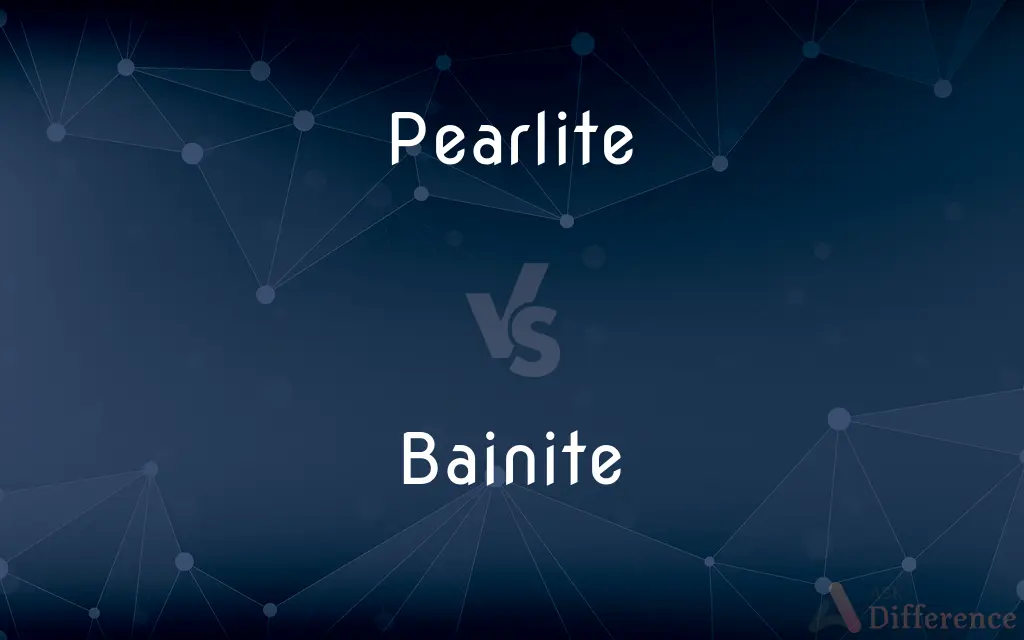Pearlite vs. Bainite — What's the Difference?
Edited by Tayyaba Rehman — By Fiza Rafique — Updated on September 26, 2023
Pearlite is a lamellar mixture of ferrite and cementite in steel, while Bainite is a microstructure of steel formed at lower transformation temperatures.

Difference Between Pearlite and Bainite
Table of Contents
ADVERTISEMENT
Key Differences
Pearlite and Bainite are both microstructures observed in steel, having unique characteristics that impact the material's mechanical properties. The differentiation between them arises primarily from the temperature at which the steel is cooled and the resultant atomic arrangements.
Pearlite forms when austenitized steel is cooled at a moderate rate, leading to a characteristic layered structure of ferrite and cementite. The presence of Pearlite in steel often imparts a combination of strength and ductility. The name "Pearlite" is derived from its mother-of-pearl appearance under the microscope.
It's essential to understand the difference between Pearlite and Bainite when considering steel's heat treatment processes. The desired mechanical properties of the steel product often dictate which microstructure is targeted during thermal treatments.
Comparison Chart
Composition
Lamellar mixture of ferrite and cementite.
Fine, non-lamellar structure of ferrite & cementite.
Formation Temp.
Moderate cooling rate.
Lower than Pearlite, above martensite.
ADVERTISEMENT
Appearance
Mother-of-pearl appearance under a microscope.
More needle-like or acicular.
Properties
Combination of strength and ductility.
Greater toughness and strength than Pearlite.
Use Cases
Gears, fasteners, and other structural applications.
High-strength, wear-resistant applications.
Compare with Definitions
Pearlite
A microstructure in steel with ferrite and cementite.
The presence of Pearlite improved the material's ductility.
Bainite
A steel microstructure formed at specific temperatures.
The component's strength was due to its Bainite structure.
Pearlite
Has a lamellar structure, resembling mother-of-pearl.
Under the microscope, the Pearlite displayed its distinctive sheen.
Bainite
Forms at temperatures between Pearlite and martensite ranges.
To achieve Bainite, the steel was cooled at a precise rate.
Pearlite
Increases both strength and ductility in steel.
The gear's Pearlite content contributed to its robust performance.
Bainite
Used in high-strength, wear-resistant applications.
The blade, made of Bainitic steel, maintained its sharpness longer.
Pearlite
Formed during moderate cooling rates from austenite.
To obtain Pearlite, the cooling process was adjusted.
Bainite
Offers steel enhanced toughness and strength.
The wear-resistance of the tool was attributed to its Bainite content.
Pearlite
Found in many structural steel applications.
The fasteners were made of steel with a high Pearlite content.
Bainite
Exhibits a needle-like appearance under microscopy.
Bainite's acicular structure was clearly visible under magnification.
Pearlite
Pearlite is a two-phased, lamellar (or layered) structure composed of alternating layers of ferrite (87.5 wt%) and cementite (12.5 wt%) that occurs in some steels and cast irons. During slow cooling of an iron-carbon alloy, pearlite forms by a eutectoid reaction as austenite cools below 723 °C (1,333 °F) (the eutectoid temperature).
Bainite
Bainite is a plate-like microstructure that forms in steels at temperatures of 125–550 °C (depending on alloy content). First described by E. S. Davenport and Edgar Bain, it is one of the products that may form when austenite (the face-centered cubic crystal structure of iron) is cooled past a temperature where it no longer is thermodynamically stable with respect to ferrite, cementite, or ferrite and cementite.
Pearlite
A mixture of ferrite and cementite forming distinct layers or bands in slowly cooled carbon steels.
Bainite
(metallurgy) A microstructure of steel consisting of needle-like particles of cementite embedded in a ferrite matrix.
Pearlite
Variant of perlite.
Pearlite
A two-phased lamellar structure composed of alternating layers of alpha ferrite and cementite that occurs in some steels and cast irons, having a pearlescent appearance.
Pearlite
(mineral) perlite
Pearlite
A glassy volcanic rock of a grayish color and pearly luster, often having a spherulitic concretionary structure due to the curved cracks produced by contraction in cooling. See Illust. under Perlitic.
Pearlite
A lamellar mixture of cementite and ferrite formed during the cooling of austenite; a micro-constituent of steel and cast iron
Common Curiosities
At what temperatures does Bainite form?
Between the Pearlite and martensite transformation temperatures.
What are Pearlite and Bainite?
Both are microstructures in steel.
Why is it called Pearlite?
Due to its mother-of-pearl appearance under microscopy.
How is Pearlite formed?
From moderate cooling rates of austenitized steel.
How can I achieve a Bainitic structure in steel?
By controlling the cooling rate and temperature.
What gives steel its various properties?
The microstructures like Pearlite, Bainite, and others.
Why is Pearlite important in metallurgy?
It provides a balance of strength and ductility to steel.
Which is more ductile, Pearlite or Bainite?
Pearlite typically offers more ductility.
How do Pearlite and Bainite look under a microscope?
Pearlite has a lamellar structure, while Bainite is needle-like.
Is Bainite stronger than Pearlite?
Yes, Bainitic steel is generally tougher and stronger.
Which microstructure is best for wear resistance?
Bainite is often favored for wear-resistant applications.
Why is Bainite's formation temperature critical?
It determines the steel's resulting mechanical properties.
In which applications might I find Bainitic steel?
High-strength tools, blades, and wear-resistant components.
Can a steel sample have both Pearlite and Bainite?
Yes, depending on the heat treatment, a sample might have multiple microstructures.
How does the cooling rate affect steel microstructures?
Faster rates might produce Bainite or martensite, slower rates produce Pearlite.
Share Your Discovery

Previous Comparison
Tide vs. Current
Next Comparison
Entrepreneur vs. IntrapreneurAuthor Spotlight
Written by
Fiza RafiqueFiza Rafique is a skilled content writer at AskDifference.com, where she meticulously refines and enhances written pieces. Drawing from her vast editorial expertise, Fiza ensures clarity, accuracy, and precision in every article. Passionate about language, she continually seeks to elevate the quality of content for readers worldwide.
Edited by
Tayyaba RehmanTayyaba Rehman is a distinguished writer, currently serving as a primary contributor to askdifference.com. As a researcher in semantics and etymology, Tayyaba's passion for the complexity of languages and their distinctions has found a perfect home on the platform. Tayyaba delves into the intricacies of language, distinguishing between commonly confused words and phrases, thereby providing clarity for readers worldwide.















































